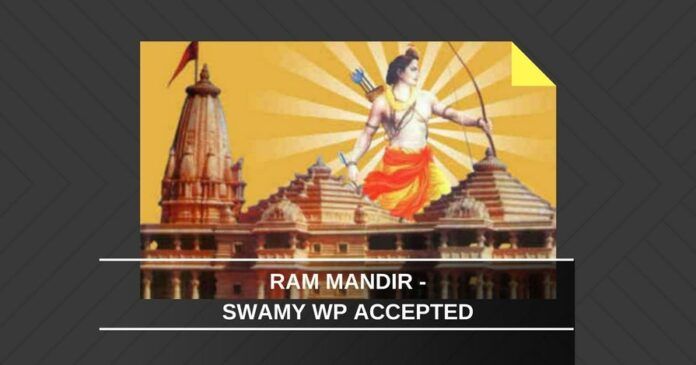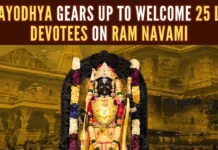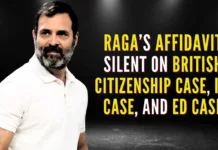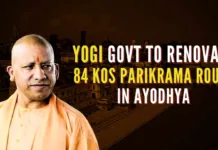
The Ayodhya case in the Supreme Court has witnessed an interesting turn of events on Wednesday. First, the Congress and Left parties-sponsored paid Liberal gang’s frivolous intervening applications to spoil the case were dismissed. Second, the Apex Court has limited the Ayodhya case to its old status of a property dispute between the Hindu – Muslim petitioners by reviving and sending the Writ Petition of Bharatiya Janata Party (BJP) leader Subramanian Swamy for Fundamental Right to Worship, to another Bench.
The third development was whether a Constitutional Bench should be constituted on the definition of Mosque by revisiting the landmark 1994 judgment known as Farooqui case to be decided on March 23.
Right at the beginning of the arguments, the Supreme Court dashed the hopes of activists like Shyam Benegal and Teesta Setalvad to intervene in the sensitive dispute case, making it clear that only the parties to the original lawsuits would be allowed to put forth their arguments. The Congress-Left parties sponsored activists were acting like pawns of their master to derail the case from coming to an early judgment. The Government and original parties agreed for rejecting all the intervening applications. Sensing the attempts to exclude him from the case, Subramanian Swamy pointed out that he filed a Writ Petition for his fundamental right to worship and another Bench of the apex court tagged his petition before this Bench as Intervening Application. It was because of Swamy’s Writ Petition that the seven-year lagging appeal on Ayodhya main case was revived last year.
The special bench headed by Chief Justice Dipak Misra and Justices Ashok Bhushan and SA Nazeer revived Swamy’s Writ Petition for consideration of “appropriate” Bench. The Judges considered Swamy’s submission that he had not sought to intervene in the matter but filed a separate writ petition seeking enforcement of his fundamental right to worship at the birthplace of Lord Ram in Ayodhya.
“I had filed a writ petition saying that I have a fundamental right to worship and this is a superior right than a property right,” Swamy said.
“As we are not inclined to permit the intervention application, the writ petition filed by the applicant (Swamy) shall stand revived and it shall be dealt with by the appropriate Bench in accordance with law,” the bench said.
The bench, after deciding the fate of the pleas for intervention, proceeded with the hearing and asked senior advocate Rajeev Dhavan, appearing for M Siddiqui, to argue and persuade it as to why these matters should be sent to a larger bench. Dhavan referred to the apex court judgment delivered in 1994 on a plea filed by M Ismail Farooqi and said the verdict had made an unwarranted comment that mosques are not integral to prayer offered by followers of Islam.
He said that “a mosque remains a mosque” and the land where the structure was there belongs to the ‘Allah’ even after the demolition. Referring to a trial court order, he said due to some political intervention, which is known to all, the idols were placed, the locks of Babri mosque were opened and the structure was finally demolished in 1992.He then referred to certain paragraphs of the 1994 judgement and assailed the view of the apex court.
The apex court had said that while an offer of prayer or worship is a “religious practice, its offering at every location where such prayers can be offered would not be an essential or integral part of such religious practice unless the place has a particular significance for that religion so as to form an essential or integral part thereof”.
“We must immediately make it clear that our addressing the said issue shall singularly relate to whether this Bench should think of, that the dictum in Dr. M Ismail Farooqi requires reconsideration
and, in that event, we may pass appropriate orders for placing the matter before a five-Judge bench for consideration of the said judgment.
“We have heard Dhavan in part with regard to the said aspect. He will develop the propositions on the next date of hearing. Let the matter be listed on March 23″, the bench said. Meanwhile, the court allowed all interim pleas of parties for bringing additional documents on record “for setting aside abatement, for condonation of delay, for substitution, for exemption from filing official translation”.
The special bench of the apex court is seized of a total of 14 appeals filed against the high court judgment delivered in four civil suits. A three-judge bench of the Allahabad High Court, in a 2:1 majority ruling, had in 2010 ordered that the land be partitioned equally among three parties — the Sunni Waqf Board, the Nirmohi Akhara and Ram Lalla.
With the Wednesday’s hearing, the Ayodhya case is now divided into old property dispute case and Swamy’s new case of Fundamental Right of Worship. The apex court’s decision whether to revisit the definition of mosque pronounced in 1994 Bench by forming Constitutional Bench may be decided in the coming hearings. If this argument is considered, the decision on the centuries’ long dispute would be again delayed in legal wrangling.
- Indian Parliament’s Special Session is convened to mark the shifting to new Parliament building - September 3, 2023
- Why did Rajat Sharma of India TV not declare that Adani owns more than 16% shares in his channel? - January 29, 2023
- Prannoy Roy to get Rs.605 crore from Adani as per Stock Exchange filing. Why is Income Tax not acting on Roys’ dues of over Rs.800 crore? - January 4, 2023











SRI R SINGH! NAMASKAR! YOU HAVE HIT THE HEAD OF NAIL AND THE NAIL WILL PIERCE ALL ANTIINDIAN HEARTS (not naming any such)
Ayodhya is place of worship for Hindus from time immemorial, much before laws are enacted and codified. All
other developments like islamic invasion, demolition of temple and forcible occupation,etc are subsequent events. It is now a question of upholding long years of faith and original history of the land or extolling as virtue the act of invasion, destruction and forcible occupation. One hopes the SC will tread cautiously and render justice to the aggrieved and affected section that bears the scars of wound inflicted by invaders and not give in to appeasement politics.
It is a matter of faith more than the property rights of the land belonging to Lord Shri Rama, as Lord Rama’s birth place. Even otherwise, Babri Mosque was built only about 450 years back by an invader, whereas Lord Shri Rama was born as per the scriptures and the planets configurations more than 7000 years ago. The Property rights can always be compensated in terms of money but not the faith of 100 Crores Hindus, besides Worshipping one’s faith being unequivocally a far superior right than the property rights.
– J. N. Kaushik Advocate Delhi –
Since this is a property dispute, why is SC even listening to Dhavan’s argument on status of mosque? Agenda or incompetence or something else?
Per Koran mosques cannot be built on disputed land.
And since all mosques are built on land illegally and violent seized from the original holders of the land, all mosques are illegal
Interesting legal case, with far reachng implications.!
All mosques are not illegal. You need to fact-check before you write such rubbish.